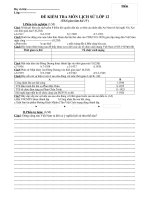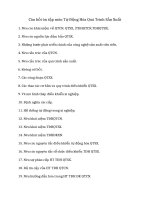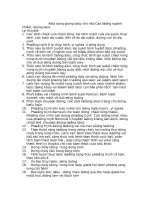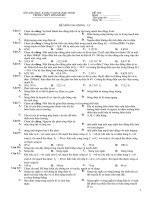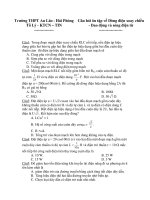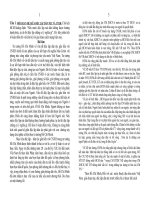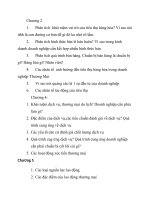CÂU hỏi ôn tập DỊCH hợp ĐỒNG FTU
Bạn đang xem bản rút gọn của tài liệu. Xem và tải ngay bản đầy đủ của tài liệu tại đây (451.46 KB, 79 trang )
CÂU HỎI ÔN TẬP DỊCH HỢP ĐỒNG
Chapter 1: Negotiating Delivery
1. The five steps in Negotiating Delivery.
To deal with problems arising if there is a delay or if delivery is not as
planned the Buyer and the Seller should negotiate delivery systematically.
That means making sure all foreseeable problems are discussed and
approaches to solving such problems are agreed. An overview of the five
negotiating steps is suggested to simplify discussion of the ideas and to
avoid problems: Timing, Location, Transport, Risk Title and Insurance,
Terms of Trade.
2. Timing: When must Delivery take place?
- Good negotiators should mention a delivery date in negotiating the timing
of an export deal and then other issues relating to coming into force, delay
and compensation for delay. Delay might be classified into two categories,
excusable and non-excusable. Excusable one involves a ‘grace period’ and is
mostly subject to a force majeure provision. Any losses to the buyer caused
by non-excusable delay must be compensated. The amount of
compensation is usually set in advance and called ‘liquidated damages’
- Use a straightforward calendar date to name the delivery date: 15 th
September 2010, for example. The parties often plan for the contract to
come into existence in two steps: the signature date and the date of coming
into force. The date of coming into force is not usually a calendar date, but
the date on which the last precondition is met. Common preconditions are:
+ Receipt of import and/ or export approval
+ Receipt of foreign exchange approval from a central bank
+ Issuance of a letter of credit or bank guarantee.
1
+ Making of a down-payment by the buyer
+ Issuance of an insurance policy
+ Issuance of a certificate of origin
+ Delivery by the buyer of plans, drawings or other documentation.
- Negotiators may agree on a cut-off date: if the contract has not come into
force within a certain time, then it becomes null and void.
Coming Into Force
This agreement shall come into force after execution by both parties on the
date of the last necessary approval by the competent authorities in the
country of the Seller and the Buyer.
If the contract has not come into force within ninety days of execution, it shall
become null and void.
Điều khoản hiệu lực
Thỏa thuận này sẽ có hiệu lực sau khi được thực hiện b ởi c ả hai bên vào ngày
phê duyệt cần thiết cuối cùng của cơ quan có thẩm quyền tại n ước ng ười
bán và người mua.
Nếu hợp đồng không có hiệu lực trong vòng chín mươi ngày kể t ừ ngày th ực
hiện, nó sẽ trở nên vô hiệu.
- The delivery date is normally fixed for a certain number of days after the
contract has come into force.
The date of delivery shall be twenty-eight days after the date of coming to
force of the contract.
2
Ngày giao hàng sẽ là 28 ngày sau ngày hợp đồng có hiệu l ực
- Time is of the essence of the contract. If the time is not kept, the buyer has
the right to return the goods and refuse payment.
Time is and shall be of the essence of the contract
Thời gian là và sẽ là vấn đề cốt lõi của hợp đồng.
- Excused Delay and Grace Period:
For each week of late delivery the Seller shall pay the Buyer 0.1 % of the
contract price.
Đối với mỗi tuần giao hàng chậm chễ người bán sẽ phải trả người mua 0.1 %
trị giá hợp đồng.
A grace period is the time exceeding the deadline for an obligation during
which a late penalty that would have been imposed is waived.
If delivery is not effected within one month of the agreed delivery date, then
the Seller shall pay the Buyer 0.1 % of the contract price.
Nếu giao hàng không được thực hiện trong vòng 1 tháng kể từ ngày giao hàng
đã được thỏa thuận thì người bán sẽ phải trả cho người mua 0.1% tr ị giá h ợp
đồng.
3
Sometimes the exporter can’t deliver the goods on time because of natural
disasters called ‘acts of God’, which is unavoidable. It is the force majeure,
which is negotiable. The parties can decide what excuses and what does not
excuse the performance in the contract.
If either party is prevented from, or delayed in, performing any duty under
this Contract by an event beyond his reasonable control, then this event shall
be deemed force majeure, and this party shall not be considered in default and
no remedy, be it under this Contract or otherwise, shall be available to the
other party. Force majeure events includes, but are not limited to: war
(whether war is declared or not), riots, insurrections, acts of sabotage, or
similar occurrences, or Government regulations, delay due to Government
action or inaction, fire, explosion, or other unavoidable accident, flood, storm,
earthquake, or other abnormal natural event.
Nếu một trong hai bên bị ngăn cản, hoặc chậm trễ trong th ực hiện bất kỳ
nghĩa vụ theo Hợp đồng này vì một sự kiện ngoài tầm ki ểm soát h ợp lý c ủa
mình, thì sự kiện này được coi là bất khả kháng, và m ặc đ ịnh là bên này sẽ
không được xem xét và không có biện pháp khắc ph ục, có th ể là theo Hợp
đồng này hoặc cách khác, sẽ có sẵn cho các bên khác. Sự kiện bất khả kháng
bao gồm, nhưng không giới hạn: chiến tranh (cho dù là tuyên bố chi ến tranh
hay không), bạo loạn, nổi dậy, hành vi phá hoại, hoặc các s ự c ố t ương t ự,
hoặc quy định của Chính phủ, chậm trễ do hành động hay không hành đ ộng
của Chính phủ, cháy, nổ, hoặc khác không thể tránh khỏi: tai nạn, lũ lụt, bão,
động đất, hoặc sự kiện tự nhiên bất thường khác..
Force majeure events do not include monsoon rains.
4
Sự kiện bất khả kháng không bao gồm mưa gió mùa.
If a force majeure condition continues for long time, contracts may regulate
the force majeure period, in particular the right of one or both parties to
terminate the contract.
If either party is prevented from or delayed in, performing any duty under this
Contract, then this party shall immediately notify the other party of the event,
of the duty affected, and of the expected duration of the event.
If any force majeure event prevents or delays performance of any duty under
this Contract for more than sixty days, then either party may on due
notification to the other party terminate this Contract.
Nếu một trong hai bên bị ngăn cản hay chậm trễ trong th ực hiện bất kỳ
nghĩa vụ theo Hợp đồng này, thì bên này sẽ ngay lập t ức thông báo cho bên kia
về sự kiện, các nghĩa vụ bị ảnh hưởng, và thời gian kéo dài d ự kiến của s ự
kiện
Nếu bất kỳ sự kiện bất khả kháng nào ngăn cản hoặc trì hoãn việc th ực hiện
các nghĩa vụ nào theo Hợp đồng này trong hơn sáu m ươi ngày, thì m ột trong
hai bên sau khi thông báo cho bên khác có th ể chấm d ứt H ợp đ ồng này.
Three outcomes of force majeure: resumption of delivery, termination of the
Contract, unclear and dangerous situation.
5
- Unexcused delay and Buyer’s Remedies: when delivery cannot take place as
planned, this causes some loss or damage to the Buyer. There are two
remedies: a decree of specific performance orders the exporter to deliver or
an award of damages makes the exporter pay compensation to the Buyer. In
addition, the court may allow the Buyer to cancel the Contract.
- Liquidated Damages: is a lump sum to be paid per day, week or month of late
delivery for compensation. Payment of liquidated damages avoids expensive
discussion. Even if the Buyer’s losses are lower or higher than anticipated,
nothing changes. The exporter pays the agreed sum, and the matter is settled.
Liquidated damages are enforceable everywhere but subject to increase or
decrease in some legal systems.
- Penalties: is the amount to be paid for late delivery. It is used as a threat of
punishment to achieve acceptable performance and is not enforceable in
English law or other common law systems.
- Quasi-indemnity: is to relieve the exporter of liability for delay in delivery. It
is enforceable everywhere but open to challenge as ‘unconsionable’.
Liquidated Damages
If the Seller fails to supply any of the Goods within the time period specified in
the Contract, the Buyer shall notify the Seller that a breach of contract has
occurred and shall deduct from the Contract price per week of delay, as
liquidated damages, a sum equivalent to one half percent of the delivered
price of the delayed Goods until actual delivery up to a maximum deduction of
10% of the delivered price of the delayed Goods
6
Thanh khoản thiệt hại
Nếu người bán không cung cấp bất kỳ hàng hóa trong khoảng th ời gian quy
định trong hợp đồng, người mua phải thông báo cho ng ười bán là m ột s ự vi
phạm hợp đồng đã xảy ra và sẽ khấu trừ giá h ợp đồng trên m ỗi tu ần trì hoãn,
làm thiệt hại thanh khoản, một khoản tiền tương đương với một nửa một
phần trăm giá được giao của hàng hóa bị chậm chễ cho đ ến khi hàng th ực tế
lên đến một mức khấu trừ tối đa là 10% giá được giao của hàng hóa b ị ch ậm
chễ.
3. Place of delivery: is the point at which the exporter passes responsibility for
the Goods to the Buyer. Delivery can take place at a number of places between
manufacturer’s factory and the Buyer’s warehouse. A contract for the sale of
Goods abroad (transportation by ship) is normally considered as an FOB (Free
on board) contract: delivery takes place when the Goods cross the rail of the
ship nominated by the Buyer. Another is CIF, the exporter pays the full costs
plus the freight charges plus insurance up to the named place of destination,
usually a port.
Delivery of the Goods shall be made FOB (Mombasa)
Giao hàng sẽ được thực hiện theo giá FOB Mombasa.
Delivery of the Goods shall be made CIF Durban.
Giao hàng sẽ được thực hiện theo giá CIF Durban
7
Delivery of the Goods shall be made (Incoterm). The schedule date of Delivery
shall be (date of delivery). Risk and title to the Goods shall pass from the Seller
to the Buyer on Delivery.
The place of Delivery under this Contract is (port of shipment)
Giao hàng được thực hiện (Incoterm). Ngày giao hàng theo lịch trình sẽ là
(ngày giao hàng). Rủi ro và quyền sở hữu các hàng hóa được chuyển từ người
bán đến
người mua khi giao hàng.
Địa điểm giao hàng theo Hợp đồng này được (cảng giao hàng)
If the vessel named by the Buyer fails to arrive on or before the agreed
delivery date, then the seller may at his discretion deliver the Goods to a
bonded warehouse in the port of Mombasa, and shall be deemed to have
fulfilled his delivery obligations under this Contract.
Nếu tàu được chỉ định bởi người mua không đến vào hoặc trước ngày giao
hàng được thỏa thuận, thì bên bán theo sự suy xét của mình có th ể giao hàng
hàng hóa đến kho ngoại quan tại cảng Mombasa, và đ ược coi là đã hoàn
thành nghĩa vụ giao hàng của mình theo hợp đồng. này
4. Transport.
- Negotiators should mention the type of packaging and the shipping marks in
the Contract.
Goods are to be packed in new, strong, wooden cases suitable for long8
distance ocean transport and are to be well protected against dampness,
shock, rust or rough handling. The Seller shall be liable for any damage to or
loss of the Goods attributable to improper or defective packaging.
Hàng hóa sẽ được đóng gói trong thùng gỗ chắc và mới thích hợp cho vận tải
biển đường dài và phải được bảo vệ chống lại độ ẩm, va đập, gỉ hoặc xử lý
thô. Người bán phải chịu trách nhiệm cho bất kỳ hư hỏng, mất mát của các
hàng hóa do bao bì không đúng hoặc bị lỗi.
On the surface of each package delivered under this Contract shall be marked:
the package number, the measurements of the package, gross weight, net
weight, the lifting position, the letter of credit number, the words RIGHT SIDE
UP, HANDLE WITH CARE, KEEP DRY, and the mark: DNP/36/Q
Trên bề mặt của mỗi kiện hang được giao theo Hợp đồng này sẽ đ ược đánh
dấu: số gói, các kích thước của gói, trọng lượng, trọng lượng tịnh, vị trí móc
cẩu, số thư tín dụng, các từ xếp theo chiều này, xếp dỡ nhẹ tay, gi ữ hang khô ,
và đánh dấu: DNP/36/Q
- On delivery, the exporter receives from the carrier the most important of
all the shipping documents, the bill of lading (consignment note). Each
mode of transport has a characteristic shipping of document: the marine
bill of lading, the airway bill, the rail consignment note, the road
consignment note. Combined transport uses a combined transport bill of
lading
9
- The Marine bill of lading is the special document used for shipment by
sea. It can be made negotiable, which means it can be bought or sold. The
word ‘Order’ makes the bill of lading negotiable. That means the shipper
must endorse the bill by signing it on the back. To be acceptable as a
shipping document under a letter of credit, it must bear the notation that
the goods have been shipped on board a named vessel.
- Payment under a letter of credit depends largely on the correctness of the
shipping documents. To be acceptable under a letter of credit, all shipping
documents must be ‘clean’, free notes about defects. It is the carrier who
notes any defects in packaging, weight, or general appearance of the goods
on accepting them from the Exporter.
5. Risk, Title and Insurance
Risk passes on delivery. Two risks are involved in the sale of goods: the risk
of the goods injuring a third party and the risk of loss or damage. These
risks are covered by insurance. In international trade, ownership (title) is
of doubtful value and passes from exporter to buyer.
Title to the goods passes with risk.
Quyền sở hữu hàng hóa gắn liền với rủi ro.
- Since merchandise is at risk at all times during its journey, it is advisable to
insure the goods. It is easier for the exporter to arrange insurance. Minimum
coverage is Cargo clause C. In CIF and CIP contracts, the exporter normally
assigns the insurance agreement to the buyer. Exporters have an agreement
with an insurance company covering the shipments over a period of time.
10
Each is covered by a certificate of insurance, which states in outline the cover
offered and gives the details of the individual shipment. There is a so-called
letter of insurance. This is a letter from the exporter to the buyer stating that
the goods are insured and it has no legal force but as evidence in a law suit
against the exporter.
- In some situation the exporter negotiates special insurance policies: floating
policy and open policy. Both offer the exporter insurance cover on all
shipment over a period of time. Open cover is not a policy, the insurer will
write a policy if required. The normal insurance document under an open
cover is the Certificate of Insurance, which is, in principle, the equivalent of a
policy.
- If the exporter insures the Goods and states on the insurance document
(valued policy), he has some decisive advantages: the pre—stated figure can
include not only the cost of the goods but also the profit the exporter hoped to
make on them. If the value is not stated (unvalued policy), then the value can
be established after a loss, the exporter must prove his figures precisely.
- A marine insurance policy has three variant clauses: Cargo Clause A, B and C.
Clause A covers anything not excluded, Clause B and C exclude anything not
expressly covered. Even an ‘all risks’ policy (Clause A) excludes many risks.
- Goods must be correctly and fully describe on the insurance document or
cover may be withdrawn and a ‘held cover’ clause offers some protection
against innocent misdescription: under given conditions the goods are held to
be covered. The main principle of insurance is ‘utmost good faith’
6. Terms of Trade
11
- The ICC publication, Incoterms 1990, gives full and clear information
about the rights and duties of buyer and exporter in Incoterm contract. The
13 terms are classified in 4 groups: E-terms, F-terms, C-terms, and D-terms.
The E-terms deals with deliveries at the exporter’s factory. The F-terms all
concern delivery within the exporter’s country. The C-terms involve
delivery in the exporter’s country, with extra costs for exporter after
delivery. D-terms take care of delivery outside the exporter’s country.
The equipment listed in Annex 1 shall be delivered FOB (Beira) (Incoterms
1990)
Các thiết bị liệt kê trong Phụ lục 1 được giao theo đi ều kiện FOB (Beira)
(Incoterms 1990)
For the equipment listed in Annex 1 the price is for delivery free on board
carrying vessel designated by the Buyer at the port of Beira including the cost
of packing, as well as expenses incurred before loading the equipment on
board the carrying vessel.
Đối với các thiết bị được liệt kê trong Phụ lục 1 giá là giá giao hàng mi ễn phí
trên boong tàu chở theo chỉ định của người mua tại cảng Beira bao g ồm chi
phí đóng gói, cũng như các chi phí phát sinh trước khi tải các trang thi ết b ị lên
boong tàu chở.
The contract should always specify that terms such as FOB, CIF and so on
are Incoterms under the rules set out in Incoterms 1990. The contract
should regulate what happens if Incoterms 1990 and the terms of the
12
contract conflict. Normally, the contract prevails. Incoterms apply only to
international trade, for trade within a country, Incoterms are not
appropriate.
Incoterms 1990 as used in this contract means the publication Incoterms
1990, being the international rules for the interpretation of their terms
published by the International Chamber of Commerce. When a term from
‘Incoterms 1990’ is used in this Contract, the rules and definitions applicable
to that term in Incoterms 1990 shall be deemed to have been incorporated in
the Contract except insofar as they may conflict with any other provision of
the Contract, in which case the Contract provisions shall prevail.
Incoterms 1990 như được sử dụng trong hợp đồng này là ấn bản Incoterms
năm 1990, là các quy tắc quốc tế cho việc diễn giải các điều kho ản c ủa chúng
do Phòng Thương mại quốc tế xuất bản. Khi một điều khoản từ "Incoterms
1990" được sử dụng trong Hợp đồng này, các quy tắc và đ ịnh nghĩa áp d ụng
cho thuật ngữ đó trong Incoterms 1990 sẽ được coi là đã đ ược k ết h ợp trong
hợp đồng ngoại trừ trường hợp chúng có thể xung đột với bất kỳ điều khoản
khác của Hợp đồng, trong trường hợp đó quy định của hợp đồng sẽ được áp
dụng.
13
CHAPTER 2: NEGOTIATING PRICE AND PAYMENT
1. EXPORT PRICING STRATEGIES
THE PROBLEM
How can the exporter avoid the “price trap” occured in many negotiations
when the buyer demands concessions about delivery time, method of
payment,etc?
THE PRINCIPLE
The exporter should guarantee that the contract price reflects any change
in a set of assumptions about delivery, payment and warranty terms.
IN MORE DEPTH
Any terms of a contract relate to each other. Therefore, as items in the
contract are negotiated, the exporter should assess the influence of each
factor on price, and adjust the price accordingly. For example, a longer
warranty period creates higher costs, it should be reflected in the contract
price. In fact, the most common term negotiated with the two sides is on
price.
Scenario: Verbena Electric hopes to export its best-selling product, small
domestic electric fans, from Verbena to Esperanza. Royalstone, the manager
of Verbena Electric, begins discussions with the purchasing manager of
Esperanza Electrical Importing, Alice Smart. Negotiations begins.
14
Royalstone offers a unit price of $22 based on some main following
assumptions:
- The size of the order is 3000 items.
- Delivery is FOB.
- The warranty period on the fans is three months from the date of
delivery.
Order Size: 3000 units is one container load, the unit price will increase on
a smaller order. An order of 1000 fans, for example, would cost $25 each –
not $22.
Incoterm: the cost of insurance and freight between Port Verbena and
Esperanza City is $520 on an order of 3000 items.
Warranty Period: Royalstone knows that a three-month warranty on an
FOB delivery produces very few claims for defects. If Smart asks for a sixmonth warranty, it will add 30 cents per fan to Royalstone’s costs.
This example shows that the negotiating decisions bear directly on the
price of the product. And a good manager knows that almost every decision
made during a negotiation incluences price.
2. THE FIVE STPES IN NEGOTIATING PAYMENT
In negotiating payment, the exporter should follow these five steps:
15
Step 1: Mode of Payment
This determines how payment will be made. There are four common mode of
payment:
payment on open account with no security: this type is seriously risky to
the exporter
payment on open account secured by export credit insurance: the
exporter pays money to an insurance company to buy an export credit
insurance
payment on open account secured by a paymenr guarantee: the buyer
pays money to a bank to receive a bank guarantee.
payment by letter of credit.: the buyer must position the money with a
bank in the coutry of the exporter and the exporter can collect that
money when the goods are delivered.
Step 2: Timing
This step determines the date of payment. The importer often wants to delay
the time of payment but the exporter suffers from delay because late payment
is subject to payment of interest so mosts sellers offer discount for early
payment. This helps the buyer save on the invoce price and the seller qickly
collect his money.
The date of payment may be regulated date or a chain of dates. It is also
calendar dates or interval times.
16
Step 3: Place of payment
This step determines where the money must be before payment is to be
completed
Step 4: Delay - what delay in payment is excusable?
Delay in payment may be excused during a grace period (not common) or a
force majeure event (more common). But most exporters do not want to
excuse these delays and any payment made after the agreed date of payment is
in delay.
Step 5: Results of delay
When delay in payment happens the exporter is usually compensated for
losses due to late payment. The exporter may ask for a payment guarantee
which makes sure payment be made on time.
The best solution to get risk of delay is to create a payment article in the sale
contract which makes late payment is impossible.
Câu trong sách - trang79
Câu dịch
Payment shall be deemed to have Việc thanh toán được cho là đã
been made only when the contract hoàn thành chỉ khi số tiền hợp
sum is paid into the Seller’s bank đồng đã được chuyển đến tài
account and is at the Seller’s full khoản ngân hàng của người Bán
17
disposal.
và do người Bán toàn quyền định
đoạt
Câu trong sách -trang 80
Câu dịch
If payment of any sum payable is Thanh toán chậm
delayed, the Buyer shall be entitled
to receive interest on the amount
unpaid during the period of delay.
The interest shall be at an annual
rate three percentage points above
the discount rate of the central
bank in the Seller’country.
Nếu chậm thanh toán bất cứ
khoản tiền nào theo hợp đồng,
bên Mua sẽ phải chịu trách nhiệm
với khoản tiền lãi tính trên khoản
tiền chưa thanh toán trong suốt
khoảng thời gian trì hoãn đó. Lãi
suất sẽ được tính cao hơn 3 % so
với lãi suất chiết khấu do Ngân
hàng Trung ương nước người bán
quy định
3. THIRD-PARTY SECURITY FOR PAYMENT
In the international trade, the exporter may face a lot of risks and one of the
significant ones is non-payment. There are two main way that the exporter
can use to reduce this risk. One is export credit insurance and the other is
bank guarantee.
Export credit insurance
Export credit insurance allows exporter to recover the major part of the
contract price if the buyer fails to pay after six months. To buy such
insurance, the exporter must explain the detail of the busineess to an
18
insurance company and receive a quotation. If the insurer refuses to pay, its
may mean that there are some problems in the exporter or importer. The
exporter has to pay export insurance premiums which depends on many
factors, such as: the type of goods exported, the creditworthiness of the
buyer, the political stability of the importer country.
Although this way is attractive, it has some limitations: the exporter has to
wait for a long time to be compensated and the compensation is unlikely to
cover 100% of the invoce price.
Payment guarantee
In this method, the buyer may ask for a bank guarantee which means that
the bank will pay the contract price if the buyer fails to do so.
Guarantees are comonly used in four business situations, as the following:
Risk 1: Non-payment =>Payment guarantee
A payment guarantee makes sure that the exporter will receive payment. It
commits the bank which issuses the payment guarantee to pay if the buyer
defaults. The payment guarantee is ussually for 100% of the contract price.
Risk 2: Revocation => Tender guarantee
This type of guarantee is used in case that the exporter who bids on a
contract to supply goods or materials to a goverment department or agency
is withdrawn. A normal figure for tender guarantee is usuallly between
1.5% to 5% of the contract price
19
Risk 3: Non-performance=>Performance guarantee
Performance guarantee makes sure that if the exporter works badly or not
at all, the guarantor will pay, within stated limits, the costs of the exporter’s
failure to perform. A figure for performance guarantee is between 5% to
10% of the contract price.
Risk 4: Losing Prepayment=>Prepayment guarantee
This guarantee promises the buyer that the bank will return advance
payments if the exporter fails to deliver. The guarantee is often for 100% of
the prepayment.
4. THE LETTER OF CREDIT
Letters of credit are issued in many forms for many purposes. Some letters
of credit offer first class security for the exporters, some are little better
than a personal check
The most ideal type of letter of credit from the exporter’s point of view is
irrevocable, comfirmed, at sight letter of credit.
The Uniform Customs and Practice for Documentary Credits (UCP) by the
International Chamber of Commerce is the most universal set of practices
rulling over payment by letter of credit. Besides, parties to a contract can
also use the rules of the United States.
20
Letter of credit: The Ground Rules
Documents are exchanged for money.
Firstly, the letter of credit is issued by an issuing bank at the request
of the buyer. The issuing bank, then, istructs the advising bank to
advise the exporter that the letter of credit has been opened.
Normally, the issuing bank is in the buyer’s country and the advising
bank is in the country of the exporter.
Next, the exporter ships the goods, passes them to the carrier and
receives shipping documents from the carrier.
Then, presents these documents to the bank as evidence that the
goods have been shipped. The bank checks the correctness of the
documents and sets the payment procedure in motion.
Two principles that make a letter of credit watertight:
Principle 1: Autonomy
The letter of credit is an agreement by a bank to pay money against
documents; It is a separate agreement from the sale contract and is
unconnected with it. This means the bank is obliged to pay whatever the
disputes between the buyer and the exporter are.
Princile 2: Strict compliance
21
The bank will pay only if the shipping documents are exactly in line with the
buyer’s instructions. In case of discrepancies in one or some aspects of the
documents presented, the bank will refuse to pay.
In this situation, to proceed payment, the exporter can:
- Provide missing payper or correct errors.
- Ask the buyer to instruct the bank to change the terms of the letter of
credit.
- Ask the bank to process the letter of credit with the discrepancies but to
pay only when and if the issuing bank permits payment.
If the letter of credit is near its expiry date and there may be no time for the
exporter to provide the missing pieces, he (or the advising bank) must contact
the buyer asking the buyer to instruct the issuing bank to extend the date of
credit.
→The exporter should provide scrupulous care in providing the
documentation called for by the letter of credit.
Page 87: The Buyer, on receipt of the Người mua, khi nhận được Chấp
Confirmation of Order from the nhận Đơn hàng từ phía người bán,
Seller, shall at least 20 days prior to phải mở một thư tín dụng đã xác
the
date
confirmed,
of
delivery
irrevocable
open
a nhân, không thể hủy ngang muộn
letter
of nhất là 20 ngày trước ngày giao
credit. This credit shall be subject to hàng. Thư tín dụng này được điều
Uniform Customs and Practice for chỉnh bởi Các Qui tắc và Thực hành
Documentary Credits, 1993 Revision, thống nhất về Tín dụng Chứng từ
ICC Publication No 500. 20% of the Số 500 của ICC, bản sửa đổi năm
22
credit shall be available against the 1993. 20% giá trị thư tín dụng này
Seller’s
draft
accompanied
by phải được thanh toán khi người bán
invoice; the remaining 80% shall be xuất trình hối phiếu và hóa đơn;
available against the Seller’s draft 80% còn lại phải được thanh toán
accompanied
by
the
shipping khi người bán xuất trình hối phiếu
documents.
và các chứng từ vận tải.
Page 90: Credits, by their nature, are Về bản chất, tín dụng là một giao
separate transactions from the sales dịch riêng biệt với các hợp đồng
or other contracts on which they mua bán hoặc các hợp đồng khác mà
may be based and banks are in no các hợp đồng này có thể là cơ sở của
way concerned with or bound by tín dụng. Các ngân hàng không liên
such contracts, even if any reference quan tới hoặc bị ràng buộc bởi các
whatsoever to such contracts is hợp đồng như thế, thậm chí ngay cả
included in the credit…In credit cả trong tín dụng có bất cứ sự dẫn
operation all parties concerned deal chiếu nào đến các hợp đồng như
in documents and not in goods, thế….Trong thanh toán bằng tín
services and/or other performances dụng, các bên chỉ chấp nhận chứng
to which the documents may relate.
từ chứ không phải là hàng hóa, dịch
vụ hay bất kì nghiệp vụ nào khác có
liên quan đến các chứng từ này.
Page 90: A letter of credit is like a bill Một thư tín dụng cũng giống như
of exchange given for the price of một tờ hối phiếu được kí phát để
goods. It ranks as cash and must be trả tiền hàng. Nó cũng là tiền và
honored. No set off or counterclaim phải được thanh toán. Nó không thể
is allowed to detract from it.
bị làm giảm giá trị bởi bất kì yêu cầu
trả tiền hay việc phản đối trả tiền
23
của bất kì bên nào.
Letter of Credit: Revocable and Irrevocable
A revocable letter of credit can be canceled at any time by the buyer or by
the issuing bank. Few exporters will accept such an arrangement, so the
plain expression “letter of credit” generally means the irrevocable kind.
UCP600 says that the letter of credit will be taken as irrevocable if nothing
is mentioned in the credit.
Letter of credit: Confirmed and Unconfirmed
A confirmed Letter of Credit is understood as the letter of credit to which a
confirmation is added by a nominated confirming bank. Confirming bank
means the bank that is asked to confirm the credit by an issuing bank. By
adding its confirmation to an L/C, it has an absolute obligation to pay the
exporter according to the terms of credit. The payment are made without
recourse, which means that if the issuing bank finds a problem with the
documents and refuses to send funds to cover the payment, the confirming
bank has no way of recovering the money it has paid to the exporter. It is
different from an advising bank which always makes payment with recourse if
it agrees to pay the value of the credit over the counter. This helps the advising
bank get its money back from the exporter if the problems occur.
Sometimes, problems can arise when very small banks or banks in countries
with severe foreign currency shortages try to instruct a bank in exporter’s
24
country to confirm a letter of credit. The issuing banks may delay in sending
funds to cover the payment.
The sign of a confirmed letter of credit is usually the cross in the “confirmation
box”.
The At-sight Letter of Credit and the Alternatives
Settlement by sight Payment
Under this method of payment, if the documents the exporter presents are in
order, the paying bank immediately pays the full face value of the letter of
credit.
Settlement by Deferred Payment
In settlement by deferred payment, the letter of credit is not payable until a
number of days after delivery. The seller presents the documents to the paying
bank, and the paying bank agrees to pay the seller the face value of the credit
when it matures. If the exporter needs ready money, he can exchange the
letter of credit for cash (at a discount) with any agreeable bank.
Settlement by Acceptance
The seller presents to the accepting bank the documents and a bill of exchange
(time draft) drawn usually on the buyer, and the bank will accept the bill of
25
